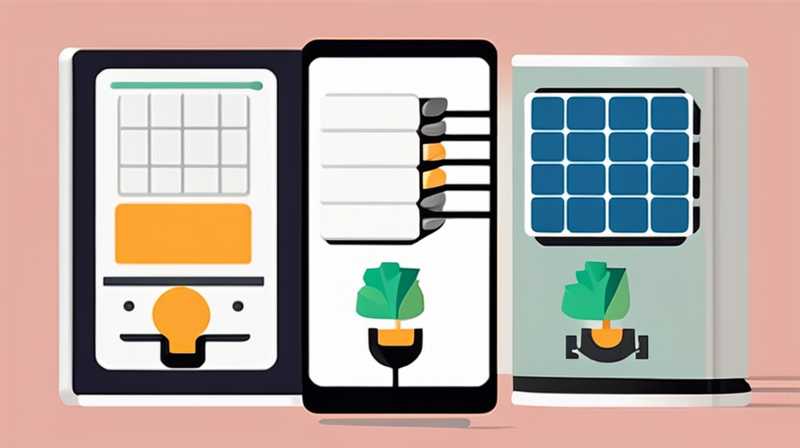
To transform solar panels into electric lights, multiple steps and components are involved. 1. START WITH SOLAR PANELS, 2. INTEGRATE A POWER STORAGE SOLUTION, 3. INSTALL A CONVERTER TO REGULATE VOLTAGE, 4. CONNECT LIGHTING DEVICES. A deeper exploration into the integration process highlights the importance of understanding how to efficiently harness solar energy. Solar panels convert sunlight into direct current (DC) electricity. To utilize it for lighting, the electricity needs to be transformed into an appropriate voltage and stored effectively for later use.
1. UNDERSTANDING SOLAR ENERGY
Delving into solar energy reveals the mechanics behind its conversion into usable forms. Solar panels, often comprised of photovoltaic cells, harness sunlight and produce electricity through the photovoltaic effect. This process is fundamental to driving the entire system that converts solar energy into electric light.
The efficiency of solar panels is influenced by factors such as material composition and installation angle. Select panels that optimize environmental conditions, as this maximizes energy harnessing. For instance, monocrystalline panels are often favored for their superior efficiency and space-saving design, making them ideal for home installations.
2. COMPONENTS REQUIRED FOR LIGHTING SYSTEM
To successfully convert solar energy to electric lighting, specific components are necessary. 1. A SOLAR PANEL, 2. A CHARGE CONTROLLER, 3. BATTERY STORAGE, 4. AN INVERTER, 5. LIGHTING FIXTURES. Each element plays a distinct role in ensuring the system functions properly.
The charge controller is crucial, as it protects the battery from overcharging and provides a regulated power supply. Proper selection of batteries is vital, too, where deep-cycle batteries are often preferred due to their ability to be drained and recharged repeatedly without losing capacity. This aspect ensures durability and reliability in energy output.
3. DESIGNING THE CIRCUIT
A critical aspect of this energy conversion process involves well-planned circuit design. This encompasses how each component interconnects and operates efficiently. Creating a schematic that accurately represents these connections can substantially aid in implementing an effective system.
Begin by determining the voltage needs of the lighting fixtures. Typically, these range from 12V to 24V, demanding a proper voltage regulation mechanism in place. This involves integrating inverters to convert DC from the solar panels to the necessary alternating current (AC). Following this configuration, fuse protection must also be incorporated to prevent electrical hazards.
4. INSTALLATION PROCESS
The installation phase must consider precise step-by-step procedures. 1. MOUNT THE SOLAR PANELS, 2. CONNECT COMPONENTS PROPERLY, 3. TEST THE SYSTEM, 4. ADJUST SETTINGS AS NECESSARY. Each of these stages demands keen attention to detail.
Proper mounting of solar panels is paramount, as it influences the amount of sunlight they receive. Use brackets designed for solar mounts to ensure optimal positioning relative to the sun. Once installed, wiring needs to be connected according to the pre-established schematic while ensuring secure and insulated connections to prevent short-circuiting.
Upon successful wiring, the testing phase will determine if each component functions harmoniously. This involves checking the output voltage and current, ensuring no faults exist before permanently securing all parts.
5. OPTIMIZING EFFICIENCY
Enhancing overall efficiency is integral for maximizing energy utilization. 1. CONDUCT REGULAR MAINTENANCE, 2. MONITOR POWER CONSUMPTION, 3. UPGRADE COMPONENTS WHEN NECESSARY. Upholding system efficiency significantly impacts the system’s performance over time.
Routine maintenance should include cleaning the solar panels to prevent dust and debris accumulation. Such blockages can impede sunlight absorption, consequently reducing energy production. Moreover, installing a monitoring system allows one to keep an eye on energy consumption patterns, identifying any discrepancies that could indicate issues.
Upgrading components periodically ensures that the system remains current with technology improvements. As the demand for efficient energy solutions grows, advancements in solar technology and batteries can help improve energy output and storage.
FAQs
WHAT TYPES OF SOLAR PANELS ARE BEST FOR LIGHTING SYSTEMS?
When selecting solar panels specifically for lighting systems, monocrystalline panels are often recommended. These panels boast higher efficiency and require less space compared to other types. Their longevity and performance in lesser light conditions also make them a viable choice for residential setups.
Additionally, polycrystalline panels serve as an alternative, typically being more affordable yet slightly less efficient. The choice may depend on budget constraints and available installation space. A thorough assessment prior to selection will greatly influence overall system performance.
HOW LONG DO SOLAR PANELS LAST?
Generally, the lifespan of solar panels is around 25 to 30 years, depending on various factors such as maintenance and environmental conditions. High-quality panels often come with warranties that guarantee performance levels within this timeframe. However, regular upkeep can extend their operational efficiency.
It’s astonishing how technology continues to advance, with many modern panels capable of lasting far beyond their original lifespan. Frequent exposure to extreme weather can affect longevity, underscoring the necessity of strategic placement and protective measures.
WHAT KIND OF LIGHTING FIXTURES CAN BE USED?
A variety of lighting fixtures is compatible with solar energy systems. LED lights are highly favored due to their energy efficiency and longevity. They consume significantly less power, making them ideal for solar applications, thus maximizing the energy produced.
Compact fluorescent lamps are another alternative, though they aren’t as efficient as LEDs. When choosing fixtures, ensure they match the output capacity of the solar system; otherwise, performance will suffer.
In summary, harnessing solar energy for lighting requires thoughtful integration of various components, each fulfilling specific functions. After understanding these complexities, the process becomes clearer and more manageable. Moreover, it’s essential to conduct routine checks to facilitate maximum efficiency in long-term operations. Remaining informed about technological advances and maintenance procedures will greatly enhance the longevity and performance of the solar-powered lighting system. By implementing a reliable installation process, energy transitions seamlessly from sunlight to versatile electric lighting solutions, satisfying both aesthetic and functional needs while also promoting sustainability. Proper planning and execution will yield results that not only illuminate spaces but also serve as a testament to the benefits of renewable energy.
Original article by NenPower, If reposted, please credit the source: https://nenpower.com/blog/how-to-make-solar-panels-into-electric-lights/


